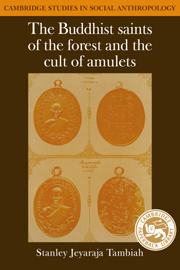Book contents
- Frontmatter
- Contents
- Acknowledgments
- Note on transcription
- 1 Introduction and manifesto
- Part I The arahant and the Path of Meditation
- Part II The hagiography of a Buddhist saint: text and context; the politics of sectarianism
- 6 The biography of a modern saint
- 7 The Buddha's life as paradigm
- 8 The ordering principles behind Buddhist saintly biography
- 9 The disciples of the Master
- 10 The biographer as exemplary forest-monk, meditator, and teacher
- 11 Sectarianism and the sponsorship of meditation
- 12 The Mahānikāi sect's propagation of lay meditation
- 13 The center–periphery dialectic: the Mahāthāt and Bovonniwet sponsorship of meditation compared
- Part III The cult of amulets: the objectification and transmission of charisma
- Part IV Conceptual and theoretical clarifications
- Notes
- Index
- CAMBRIDGE STUDIES IN SOCIAL ANTHROPOLOGY
9 - The disciples of the Master
Published online by Cambridge University Press: 10 December 2009
- Frontmatter
- Contents
- Acknowledgments
- Note on transcription
- 1 Introduction and manifesto
- Part I The arahant and the Path of Meditation
- Part II The hagiography of a Buddhist saint: text and context; the politics of sectarianism
- 6 The biography of a modern saint
- 7 The Buddha's life as paradigm
- 8 The ordering principles behind Buddhist saintly biography
- 9 The disciples of the Master
- 10 The biographer as exemplary forest-monk, meditator, and teacher
- 11 Sectarianism and the sponsorship of meditation
- 12 The Mahānikāi sect's propagation of lay meditation
- 13 The center–periphery dialectic: the Mahāthāt and Bovonniwet sponsorship of meditation compared
- Part III The cult of amulets: the objectification and transmission of charisma
- Part IV Conceptual and theoretical clarifications
- Notes
- Index
- CAMBRIDGE STUDIES IN SOCIAL ANTHROPOLOGY
Summary
Before I embark on the third complex frame of analysis that will complete my interpretation of the biography, I want to again introduce the concept of indexical symbol as a useful device for comprehending how all the layers of meaning and significance, both “semantic” and “pragmatic”, ride simultaneously on the same “form” (the biography) and thus constitute a single totality of meaning.
The main point about indexical symbols, as I have already stated in Chapter I, is that they have a duplex structure, because they combine two roles – they are symbols that are associated with the represented object by a conventional semantic rule, and they are simultaneously also indexes in existential pragmatic relation with the objects they represent. This duality thus points in two directions at once – toward the semantic direction of cultural presuppositions, paradigms, and conventional understandings; and toward the pragmatic and interpersonal context of the activity in question, the lineup of the participants and the processes by which they establish meaning, and create, affirm, or legitimate their positions and privileges.
Let me relate these conceptual and analytical statements to this book. The biography of Acharn Mun is an indexical symbol in the sense that on the one hand the saint's life is symbolically and semantically related to the classical conventional hagiographies of the Buddha and exemplary Buddhist saints (the theme of the preceding two chapters), and on the other hand the composition is indexically and pragmatically related to the purposes and objectives of the disciple-author, the context in which he composed it, and its distribution to and reception by the public, who are its readers and audience. This latter exegesis is the task of this and the succeeding two chapters.
- Type
- Chapter
- Information
- The Buddhist Saints of the Forest and the Cult of Amulets , pp. 132 - 141Publisher: Cambridge University PressPrint publication year: 1984



